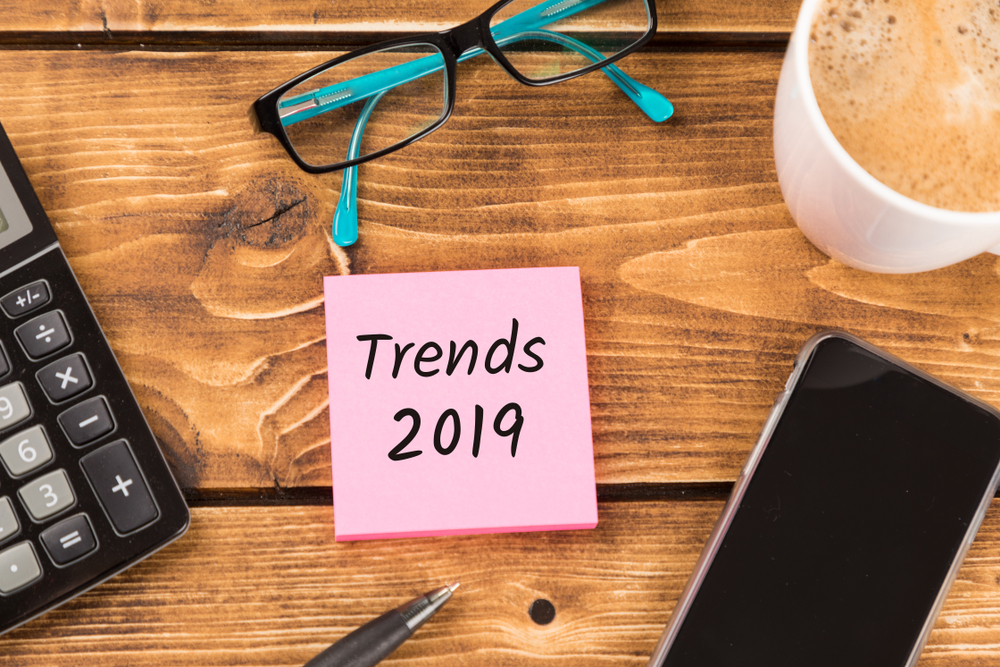
Perhaps more than any sector, owners of ecommerce websites ought to be aware of upcoming web design trends. 2019 is likely to usher in a whole of new ideas as companies try their best to meet the demands of Google’s ever-changing algorithms, whilst also looking to retain their existing client base.
The following list – Top Web Design Trends 2019 – should prove invaluable to all ecommerce websites, but it does come with the following caveat:
There are certain things that crop up in every year’s top web design trends, 2019 being no different. Things like voice-activated searches, more video content, larger typography and so on make these lists every year without fail. Frankly, if you haven’t already considered those particular additions to your ecommerce websites, the following insights might be a little outside of your comfort zone.

Free-form design
It seems that developers and consumers alike have fallen out of love with ready-made website templates, and it’s understandable. Even a casual glance around the internet shows a certain uniformity of web design, with ecommerce shop fronts and WordPress templates being so ubiquitous that things start to feel a little same. While there is certainly something to be said for familiarity, particularly from a marketing perspective, with people spending so much time online it’s going to take more than a perfectly tabulated online store to grab the attention of a potential lead. Web developers need to embrace the fluidity of the internet and remember that their work, at its best, is an art rather than a science. A unique look and an enticing design can attract more customers than the most rigorous coding in the world, and 2019 looks set to be a timely reminder of that.

Content, content, content
The maxim that content is king has been true for some time now, but 2019 will see that trend expand beyond all measure. With so many web design and website maintenance moving to automated solutions, the human touch becomes even more important. All the big players – Google, Facebook, Twitter, YouTube, and so on – have already recognised this to be the case. Google algorithms, in particular, are heavily weighted towards fresh original content, and the more the better.
Of course, we’re not just looking at quantity, quality is just as important. Perhaps more so, since search engines are clamping down on plagiarism left, right, and centre. Simply copying a report from a news site and including it on your own will no longer suffice. As 2019 rolls on, it seems likely that rewriting and replacing keywords will trigger similar alarm bells. As we let our own automated systems handle the day-to-day operation of our websites, it will be down to artists, the writers, the musicians, and the graphic designers to bring the heavy stuff, creating quality content designed to get people speaking about your service or product.
Customer data
We all want to know more about our customers, in order to provide them with a better service, but this aspect of online business took an abrupt turn in 2018 with the introduction of GDPR. The General Data Protection Regulation rolled out across the EU in May of last year, granting better protection to customers and consumers. Collecting data about customers now became a matter of informed consent, where they had to be advised of every piece of information they were handing over and what it could be used for.
That there were several high-profile data violations that same year (Facebook being perhaps the most notorious one) did little to relieve the pressure on online companies. Customer privacy is a hot topic and the next twelve months will see major changes in the way websites collate data. Key points for any developer will include what information is asked for at the sign-up stage and whether it would be deemed essential in a court of law. In theory, this will lead to greater transparency for consumers, which can only be a good thing. In practice, it means an end to data-mining, meaning that demographic research will need to be handled in the open.
Fighting back against bias
This one has been a long time coming. At the moment, many consumer algorithms are geared towards finding the largest pot of potential clients. Whether by accident or design, this tends to sideline consumers outside of that key demographic and lump them all together as anomalies to the pattern our algorithms are looking for. In truth, the situation is rarely as clear-cut as ‘these are our customers’ vs. ‘these are not our customers’.
There is a huge and intricate Venn diagram of connections and crossovers, spiralling outwards and creating new links among potential clients from all walks of life. The Internet makes it easy for anybody to find your company, but your algorithms might be turning away perfectly good business. The message for 2019 is twofold. First, embrace the outliers, and bring them into that core of consumers you crave so badly. Secondly, be aware of the unintentional bias you demonstrate when you predict that only a certain subsection of humanity will be interested in your product or service.
Getting personal
Personalised content is nothing new – anybody who has ever searched for a product and then found themselves bombarded with adverts for the same thing every time they local onto social media can attest to that. However, 2019 look set to change this paradigm from ‘here are some other products you might be interested in’ to omnichannel content that provides an end-to-end user experience. At the moment, a user’s journey is defined by the medium they employ.
Walking into a brick-and-mortar store, using ecommerce websites on their desktop, and using an optimised shopping app are all different journeys with different outcomes. Omni-channel content seeks to combine those journeys into a single user experience – one that grows and develops over time, no matter how they choose to interact with your brand. This will not be a short-term solution, by any means. In many cases it will involve redesigning websites from the ground up to incorporate all aspects of the client journey, to introduce new algorithms that connect with customers at key milestones, and to take advantage of latest AI and chatbot developments. That said, as daunting a prospect as it might seem, it has to start somewhere, and 2019 looks to be the jumping-off point.
Storytelling
It may seem an odd choice but, as with all of these web design trends, 2019 looks set to be a year of doing things differently. Storytelling is a key component of any development process, be it social, physical, legal, or technological. As a species, we are hard-wired to spot the narrative in situations, whether consciously or unconsciously. Furthermore, we have a deep-rooted psychological desire to insert ourselves into stories and, moreover, to see ourselves as the heroes of these stories. As a cutting-edge industry, we sometimes think that all the important answers come from technology, but we ignore traditional storytelling at our peril. It is how we connect with our audience, how we draw them in. Indeed storytelling is the very basis of building a platform and establishing brand loyalty. However great the product, nothing makes a customer happier than feeling that they’re participating in something bigger, something of consequence. This is where storytelling can make all the difference.
Progressive web apps
Okay, so these have been around for a while – since 2015, in fact – but 2019 looks to be the year that they will make a massive impact in all kinds of sectors. So what exactly are they? Well, progressive web apps (or PWAs as they’re commonly referred to as online) are a clever blending of the very best that online websites and offline apps have to offer. In short, they are web-based tools that can be accessed anywhere without the requirement of downloading a bespoke app to your iOS or Android device. In terms of functionality, the only limitation is the imagination of the web developer.
Already there are PWAs for image manipulation, file conversion, website creation and so on, but the growth in this particular field looks set to enter uncharted territory. The benefits are obvious – they provide a consistent user experience however they choose to access it (via desktop, laptop, or mobile device), they don’t require any external storage for the app itself or any user-created files, and users are automatically using the latest version as that will be part of the website infrastructure. The very best of these PWAs will also adapt and adjust to the user, continuously improving their experience with the app.
For more information on what web design trends 2019 has in store for ecommerce websites the world over, be sure to get in touch with anova today for a detailed consultation on how to make your website stand out during the next twelve months.
Related article: Top 7 Reasons Why Magento Is the Choice for eCommerce


